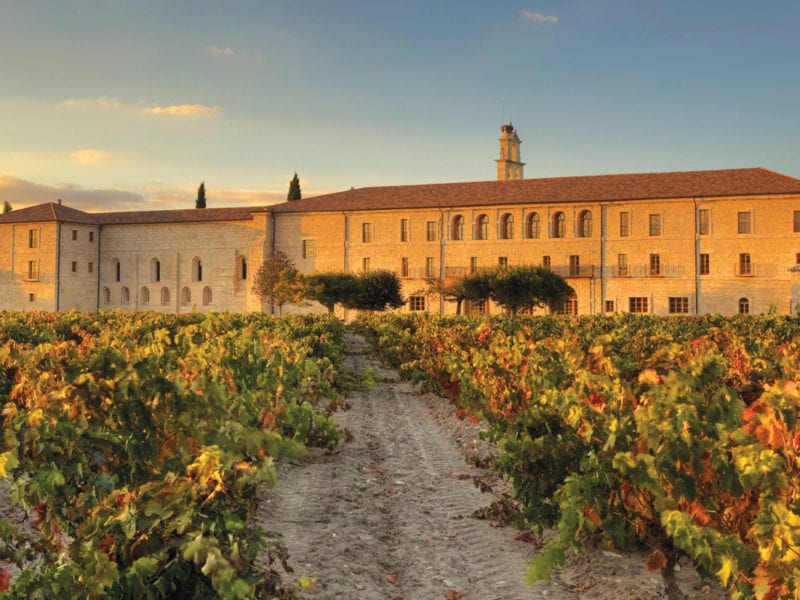
By Rich Warren
Wine lovers surely took note this year of the New York Times’ selection of Spain’s Ribera del Duero wine region as one of its “52 places to go in 2018.” Just an hour north of Madrid by high-speed train or two hours by car, the region is coming into its own as a tourist destination. Visitors will find a land of castles, cathedrals, and ancient walled cities tucked into the historic Spanish province of Castile-Leon.
And yes, a river runs through it. The beautiful Duero River, with plentiful vineyards adorning its valley, gives the region its name: Ribera del Duero means “banks of the Duero” in Spanish.
Expect to find full-bodied red wines here. As part of the Spanish “denomination of origin” (D.O.) regulatory system, wines in the designated district are required to use a minimum of 75 percent Tempranillo grapes, though they’re often complemented by Cabernet Sauvignon, Malbec and Merlot. Different designations of the local wines such as Joven, Crianza, and Reserva indicate how long the wines have aged in oak barrels and in the bottle.
Winery-hopping is a popular activity in Ribera del Duero, and it’s easy to do. Along the so-called “Golden Mile” (actually, more like six miles!), one winery after another abuts the main highway through the region, with others sprinkled throughout the hills and elsewhere. During my visit last year, we stopped at two bodegas of Grupo Matarromera. At the first, Rento, we used pipettes to draw aging wine out of barrels for our tastings, and at the second, Emina, we sampled wines while learning about its line of cosmetics, Esdor, that are made with polyphenols extracted from grape stems and seeds.
Then we headed for the hilltop winery, Portia, where the stunning architecture impresses visitors as much as the wine itself. Designed by British “starchitect” Norman Foster, the huge structure filled with artwork resembles a three-pointed star on the exterior.
Other potential stops in the region include Vega Sicilia, founded in 1864, and Tinto Pesquera, where legendary winemaker Alejandro Fernandez put Ribera del Duero on the map with his exquisite wines: his 2012 Reserva was recently named one of the top 100 in the world by Wine & Spirits Magazine.
The historic region offers plentiful diversions not related to wine. The cities of Salamanca, Segovia, and Ávila are all UNESCO World Heritage sites inside Castile-Leon, within easy reach of Ribera del Duero. My group took a walking tour of Valladolid, Spain’s capital centuries before it moved to Madrid. It’s where Ferdinand and Isabella were married, and it’s also the site where Christopher Columbus died.
Smaller towns offer charms as well. Above the alluring little town of Peñafiel, where bull fights periodically take place in the town square, floats a castle that looks like a ship high atop a hill overlooking the town. And a fascinating wine museum awaits inside.
The town of Aranda de Duero is the unofficial capital of Ribera del Duero. A warren of interconnecting wine cellars, some cut into sheer rock, extend beneath its cobblestoned streets.
Other fascinating activities my group enjoyed included hearing monks singing Gregorian chants at the Benedictine monastery at Santo Domingo de Silos. We also watched dogs hunting for truffles outside the town of Soria — unlike pigs, dogs don’t try to eat the prized delicacies once they’ve unearthed them. And of course we ate like royalty wherever we went. We sampled several truffle dishes at Baluarte, a Michelin-starred restaurant in Soria. And several times, we had the chance to partake of roasted milk-fed lamb, a regional specialty.
Lodging options include Spanish paradores — comfortable hotels housed inside repurposed historic buildings like former palaces, castles, and monasteries. We stayed in one high on a hilltop overlooking Soria with panoramic views of the mountains and Duero River.
A worthwhile splurge is the magnificent LeDomaine, a five-star hotel inside what was once a monastery dating to the 12th century. Described by the New York Times as “one of Spain’s finest hotels,” its wide hallways with frescoes, tapestries, and high-vaulted ceilings; Gothic cloisters; and a Romanesque church now used for public events combine to exude a Zen-like atmosphere. The hotel’s stunning restaurant, Refectorio, where the former monastery’s monks once ate their meals, just adds to the monastic vibe – and it too holds a Michelin star.
With 1,700 acres of vineyards surrounding the former monastery, wine becomes an important part of the experience at LeDomaine. The estate winery, Abadia Retuerta, lies just outside the official boundaries of the Ribera del Duero D.O., allowing it the opportunity to experiment with different grape varieties. I was especially fond of their outstanding white blend using Sauvignon Blanc and a touch of Verdejo.
The “oenological immersion” at LeDomaine ranges from wine tastings to rides through the vineyards in a Land Rover to the opportunity to help with the harvest. Even LeDomaine’s spa, Santuario, has a wine component to it. Treatments begin with a wine tasting. Based on the guest’s wine preference, their “spa sommelier” decides the oils to be used during their massages, facials, or body scrubs, pairing the properties of the wines with those of the oils. Call it a form of “vinotherapy.”
Obviously, the wines of Ribera del Duero are the principal draw to the region, but visitors will be delighted by other diversions aplenty that make a stay in this wine region well worthwhile.
Photo courtesy of Abadia Retuerte LeDomaine.


Please don’t lead people to believe they can stop at Vega Sicilia. They really aren’t open to the public.
Thank you Dan for the information.